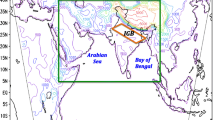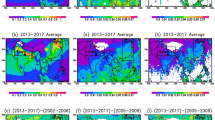Abstract
Nitrate as a rapidly increasing aerosol species in recent years affects the present climate and potentially has large implications on the future climate. In this study, the long-term direct radiative forcing (DRF) of nitrate aerosol is investigated using State Key Laboratory of Numerical Modeling for Atmospheric Sciences and Geophysical Fluid Dynamics (LASG) atmospheric general circulation model (AGCM) and the aerosol dataset simulated by a chemical transport model with focus on East Asia. The DRF due to other aerosols, especially sulfate, is also evaluated for comparisons. Although the chemical transport model underestimates the magnitudes of nitrate and sulfate aerosols when compared with Chinese site observations, some insights into the significances of nitrate climate effects still emerge. The present-day global annual mean all-sky DRF of nitrate is calculated to be −0.025 W m−2 relative to the preindustrial era, which is much weaker than −0.37 W m−2 for sulfate. However, nitrate DRF may become increasingly important in the future especially over East Asia, given the expectation that decreasing trend in global sulfate continues while the projected nitrate maintains at the present level for a mid-range forcing scenario and even be a factor of two larger by the end of the 21st century for high emission scenarios. For example, the anthropogenic nitrate DRF of −2.0 W m−2 over eastern China could persist until the 2050s, and nitrate is projected to account for over 60 % of total anthropogenic aerosol DRF over East Asia by 2100. In addition, we illustrate that the regional nitrate DRF and its seasonal variation are sensitive to meteorological parameters, in particular the relative humidity and cloud amount. It thus remains a need for climate models to include more realistically nitrate aerosol in projecting future climate changes.












Similar content being viewed by others
References
Adams PJ, Seinfeld JH, Koch D, Mickley L, Jacob D (2001) General circulation model assessment of direct radiative forcing by the sulfate‐nitrate‐ammonium‐water inorganic aerosol system. J Geophys Res 106(D1):1097–1111
Bao Q, Lin PF, Zhou TJ et al (2013) The Flexible Global Ocean–Atmosphere-Land system model, Spectral Version 2: FGOALS-s2. Adv Atmos Sci 30(3):561–576
Bauer SE, Koch D, Unger N, Metzger SM, Shindell DT, Streets DG (2007) Nitrate aerosols today and in 2030: a global simulation including aerosols and tropospheric ozone. Atmos Chem Phys 7:5043–5059
Bellouin N, Rae J, Jones A, Johnson C, Haywood J, Boucher O (2011) Aerosol forcing in the Climate Model Intercomparison Project (CMIP5) simulations by HadGEM2-ES and the role of ammonium nitrate. J Geophys Res 116(D20):D20206. doi:10.1029/2011JD016074
Chou MD (2002) Parameterization of shortwave cloud optical properties for a mixture of ice particle habits for use in atmospheric models. J Geophys Res 107:4600. doi:10.1029/2002JD002061
Edwards JM, Slingo A (1996) A studies with a flexible new radiation code. I: choosing a configuration for a large-scale model. Q J R Meteorol Soc 122:689–720
Fitzgerald JW (1975) Approximation formulas for the equilibrium size of an aerosol particle as a function of its dry size and composition and the ambient relative humidity. J Appl Meteorol 14:1044–1049
Folini D, Wild M (2011) Aerosol emissions and dimming/brightening in Europe: sensitivity studies with ECHAM5-HAM. J Geophys Res 116:D21104. doi:10.1029/2011JD016227
Forster P, Ramaswamy V, Artaxo P et al (2007) Changes in atmospheric constituents and in radiative forcing. In: Climate change 2007: the physical science basis. Contribution of Working Group I to the Fourth Assessment Report of the Intergovernmental Panel on Climate Change. Cambridge University Press, Cambridge, United Kingdom, and New York, NY, USA
Fu Q, Liou KN (1992) On the correlated k-distribution method for radiative transfer in nonhomogeneous atmospheres. J Atmos Sci 49:2139–2156
Haywood JM, Ramaswamy V (1998) Global sensitivity studies of the direct radiative forcing due to anthropogenic sulphate and black carbon aerosols. J Geophys Res 103:6043–6058
He B, Bao Q, Li J et al (2013) Influences of external forcing changes on the summer cooling trend over East Asia. Clim Change 117:829–841
Hess M, Koepke P and Schult I (1998) Optical properties of aerosols and clouds: The software package OPAC. Bull Am Meteorol Soc 79:831–844
Hu YX, Stamnes K (1993) An accurate parameterization of the radiative properties of water clouds suitable for use in climate models. J Clim 6:728–742
Kiehl JT, Schneider TL, Rasch PJ, Barth MC, Wong J (2000) Radiative forcing due to sulfate aerosols from simulations with the National Center for Atmospheric Research Community Climate Model Version 3. J Geophys Res 105(D1):1441–1457
Lamarque JF, Kyle GP, Meinshausen M et al (2011) Global and regional evolution of short-lived radiatively-active gases and aerosols in the Representative Concentration Pathways. Clim Change 109:191–212
Lamarque JF et al (2012) CAM-chem: description and evaluation of interactive atmospheric chemistry in the Community Earth System Model. Geosci Model Dev 5:369–411
Li J, Barker HW (2005) A radiation algorithm with correlated k-distribution. Part I: local thermal equilibrium. J Atmos Sci 62:286–309
Li J, Wong JGD, Dobbie JS, Chylek P (2001) Parameterization of the optical properties of sulfate aerosols. J Atmos Sci 58:193–209
Li Z, Lee KH, Xin J, Wang Y, Hao WM (2010) First observation-based estimates of cloud-free aerosol radiative forcing across China. J Geophys Res 115:D00K18. doi:10.1029/2009JD013306
Li JD, Sun Z, Liu YM, Li JN, Wang WC, Wu GX (2012) A study on sulfate optical properties and direct radiative forcing using LASG-IAP general circulation model. Adv Atmos Sci 29(6):1185–1199
Liao H, Seinfeld JH (2005) Global impacts of gas-phase chemistry-aerosol interactions on direct radiative forcing by anthropogenic aerosols and ozone. J Geophys Res 110:D18208. doi:10.1029/2005JD005907
Liao H, Seinfeld JH, Adams PJ, Mickley LJ (2004) Global radiative forcing of coupled tropospheric ozone and aerosols in a unified general circulation model. J Geophys Res 109:D16207. doi:10.1029/2003JD004456
Liao H, Zhang Y, Chen WT, Raes F, Seinfeld JH (2009) Effect of chemistry-aerosol-climate coupling on predictions of future climate and future levels of tropospheric ozone and aerosols. J Geophys Res 114:D10306. doi:10.1029/2008JD010984
Liu X, Easter RC, Ghan SJ et al (2012) Toward a minimal representation of aerosols in climate models: description and evaluation in the Community Atmosphere Model CAM5. Geosci Model Dev 5:709–739
Lu Z, Streets DG, Zhang Q et al (2010) Sulfur dioxide emissions in China and sulfur trends in East Asia since 2000. Atmos Chem Phys 10:6311–6331
Martin G, Ringer M, Pope V, Jones A, Dearden C, Hinton T (2006) The physical properties of the atmosphere in the new Hadley Centre Global Environmental Model (HadGEM1). Part I: model description and global climatology. J Clim 19(7):1274–1301
Mlawer EJ, Taubman SJ, Brown PD, Iacono MJ, Clough SA (1997) Radiative transfer for inhomogeneous atmospheres: RRTM, a validated correlated-k model for the longwave. J Geophys Res 102(D14):16663–16682
Myhre G, Shindell D, Bréon F-M et al (2013a) Anthropogenic and natural radiative forcing. In: Stocker TF, Qin D, Plattner G-K, Tignor M, Allen SK, Boschung J, Nauels A, Xia Y, Bex V, Midgley PM (eds) Climate change 2013: the physical science basis. Contribution of Working Group I to the Fifth Assessment Report of the Intergovernmental Panel on Climate Change. Cambridge University Press, Cambridge
Myhre G, Samset BH, Schulz M et al (2013b) Radiative forcing of the direct aerosol effect from AeroCom Phase II simulations. Atmos Chem Phys 13(4):1853–1877
Pathak RK, Yao XH, Chan CK (2004) Sampling artifacts of acidity and ionic species in PM2.5. Environ Sci Technol 38:254–259
Richter A, Burrows JP, Nuss H, Granier C, Niemeier U (2005) Increase in tropospheric nitrogen dioxide over China observed from space. Nature 437(7055):129–132
Schaap M, Loon MV, ten Brink HM, Dentener FJ, Builtjes PJH (2004) Secondary inorganic aerosol simulations for Europe with special attention to nitrate. Atmos Chem Phys 4:857–874
Schulz M, Textor C, Kinne S et al (2006) Radiative forcing by aerosols as derived from the AeroCom present-day and pre-industrial simulations. Atmos Chem Phys 6:5225–5246
Shindell DT, Lamarque JF, Schulz M et al (2013) Radiative forcing in the ACCMIP historical and future climate simulations. Atmos Chem Phys 13(6):2939–2974
Skeie RB, Berntsen TK, Myhre G et al (2011) Anthropogenic radiative forcing time series from pre-industrial times until 2010. Atmos Chem Phys 11:11827–11857
Smith SJ, Aardenne JV, Klimont Z, Andres RJ, Volke A, Arias SD (2011) Anthropogenic sulfur dioxide emissions: 1850–2005. Atmos Chem Phys 11(3):1101–1116
Sun Z (2011) Improving transmission calculations for the Edwards–Slingo radiation scheme using a correlated-k distribution method. Q J R Meteorol Soc 137(661):2138–2148
Sun Z, Rikus L (1999) Improved application of ESFT to inhomogeneous atmosphere. J Geophys Res 104:6291–6303
Sun YL, Jiang Q, Wang ZF et al (2014) Investigation of the sources and evolution processes of severe haze pollution in Beijing in January 2013. J Geophys Res 119:4380–4398. doi:10.1002/2014JD021641
Takemura T (2012) Distributions and climate effects of atmospheric aerosols from the preindustrial era to 2100 along Representative Concentration Pathways (RCPs) simulated using the global aerosol model SPRINTARS. Atmos Chem Phys 12(23):11555–11572
Takemura T, Nakajima T, Dubovik O, Holben BN, Kinne S (2002) Single scattering albedo and radiative forcing of various aerosol species with a global three-dimensional model. J Clim 15:333–352
Taylor KE, Stouffer RJ, Meehl GA (2012) An overview of CMIP5 and the experiment design. Bull Am Meteorol Soc 93(4):485–498
Toon OB, Pollack JB, Khare BN (1976) The optical constants of several atmospheric aerosol species: ammonium sulfate, ammonium oxide and sodium chloride. J Geophys Res 81:5733–5748
Vuuren DP, Edmonds J, Kainuma M et al (2011) The representative concentration pathways: an overview. Clim Change 109:5–31
Wang T, Li S, Shen Y, Deng J, Xie M (2010) Investigations on direct and indirect effect of nitrate on temperature and precipitation in China using a regional climate chemistry modeling system. J Geophys Res 115:D00K26. doi:10.1029/2009JD013264
Wu G, Liu YM, He B et al (2012) Thermal controls on the Asian summer monsoon. Sci Rep 2:404. doi:10.1038/srep00404
Xu L, Penner JE (2012) Global simulations of nitrate and ammonium aerosols and their radiative effects. Atmos Chem Phys 12(20):9479–9504
Zhang XY, Wang YQ, Niu T et al (2012a) Atmospheric aerosol compositions in China: spatial/temporal variability, chemical signature, regional haze distribution and comparisons with global aerosols. Atmos Chem Phys 12(2):779–799
Zhang H, Shen Z, Wei X, Zhang M, Li Z (2012b) Comparison of optical properties of nitrate and sulfate aerosol and the direct radiative forcing due to nitrate in China. Atmos Res 113:113–125
Zhang H, Wang ZL, Wang ZZ et al (2012c) Simulation of direct radiative forcing of aerosols and their effects on East Asian climate using an interactive AGCM-aerosol coupled system. Clim Dyn 38:1675–1693
Acknowledgments
This research was supported jointly by the National Basic Research Program of China (Grant Nos. 2013CB955803 and 2012CB955303) and the Office of Biological and Environmental Sciences, USA Department of Energy (grant to SUNYA). The authors would like to thank Dr. Lamarque of the NCAR for providing the NCAR CAM-Chem aerosol mass dataset.
Author information
Authors and Affiliations
Corresponding author
Rights and permissions
About this article
Cite this article
Li, J., Wang, WC., Liao, H. et al. Past and future direct radiative forcing of nitrate aerosol in East Asia. Theor Appl Climatol 121, 445–458 (2015). https://doi.org/10.1007/s00704-014-1249-1
Received:
Accepted:
Published:
Issue Date:
DOI: https://doi.org/10.1007/s00704-014-1249-1




